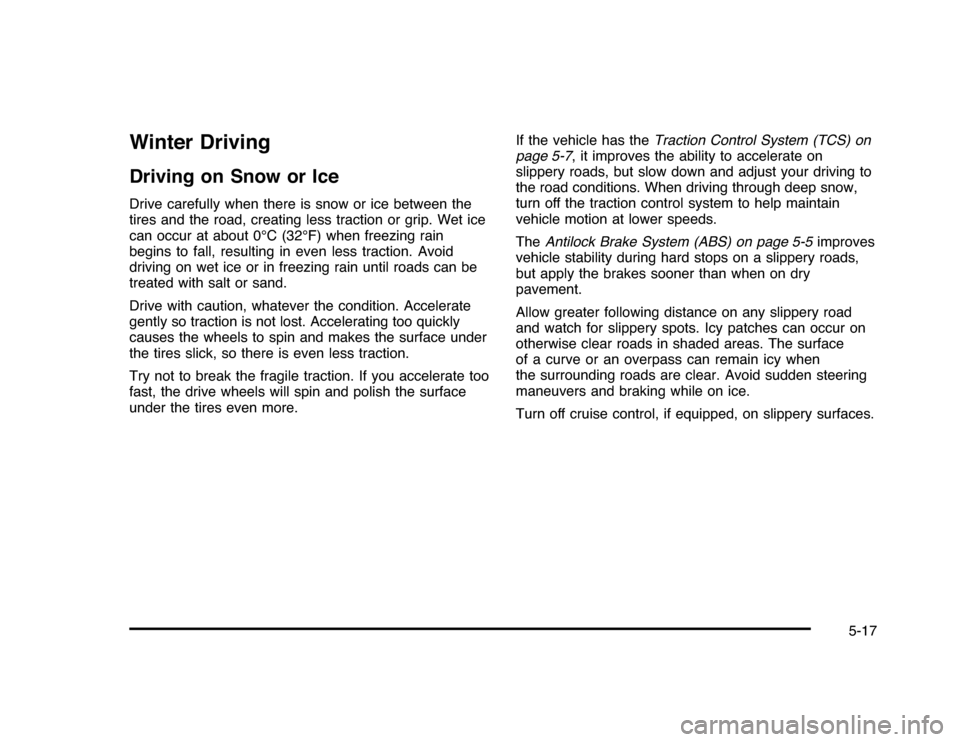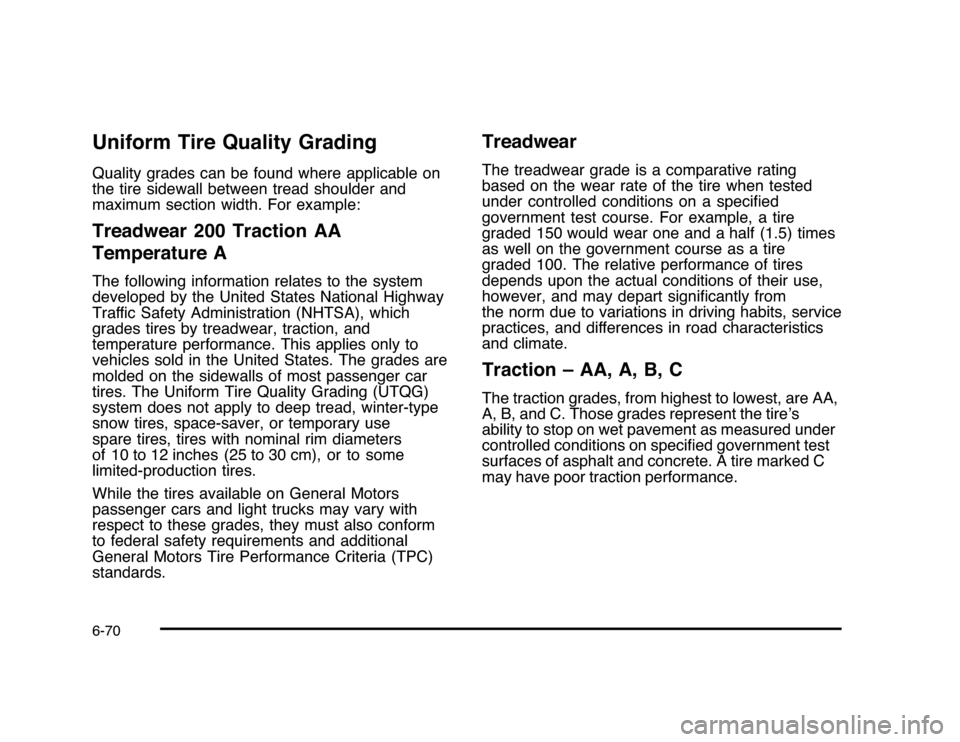Page 253 of 432

Winter DrivingDriving on Snow or IceDrive carefully when there is snow or ice between the
tires and the road, creating less traction or grip. Wet ice
can occur at about 0°C (32°F) when freezing rain
begins to fall, resulting in even less traction. Avoid
driving on wet ice or in freezing rain until roads can be
treated with salt or sand.
Drive with caution, whatever the condition. Accelerate
gently so traction is not lost. Accelerating too quickly
causes the wheels to spin and makes the surface under
the tires slick, so there is even less traction.
Try not to break the fragile traction. If you accelerate too
fast, the drive wheels will spin and polish the surface
under the tires even more.If the vehicle has theTraction Control System (TCS) on
page 5-7, it improves the ability to accelerate on
slippery roads, but slow down and adjust your driving to
the road conditions. When driving through deep snow,
turn off the traction control system to help maintain
vehicle motion at lower speeds.
TheAntilock Brake System (ABS) on page 5-5improves
vehicle stability during hard stops on a slippery roads,
but apply the brakes sooner than when on dry
pavement.
Allow greater following distance on any slippery road
and watch for slippery spots. Icy patches can occur on
otherwise clear roads in shaded areas. The surface
of a curve or an overpass can remain icy when
the surrounding roads are clear. Avoid sudden steering
maneuvers and braking while on ice.
Turn off cruise control, if equipped, on slippery surfaces.
5-17
Page 340 of 432

Uniform Tire Quality GradingQuality grades can be found where applicable on
the tire sidewall between tread shoulder and
maximum section width. For example:Treadwear 200 Traction AA
Temperature AThe following information relates to the system
developed by the United States National Highway
Traffic Safety Administration (NHTSA), which
grades tires by treadwear, traction, and
temperature performance. This applies only to
vehicles sold in the United States. The grades are
molded on the sidewalls of most passenger car
tires. The Uniform Tire Quality Grading (UTQG)
system does not apply to deep tread, winter-type
snow tires, space-saver, or temporary use
spare tires, tires with nominal rim diameters
of 10 to 12 inches (25 to 30 cm), or to some
limited-production tires.
While the tires available on General Motors
passenger cars and light trucks may vary with
respect to these grades, they must also conform
to federal safety requirements and additional
General Motors Tire Performance Criteria (TPC)
standards.
TreadwearThe treadwear grade is a comparative rating
based on the wear rate of the tire when tested
under controlled conditions on a specified
government test course. For example, a tire
graded 150 would wear one and a half (1.5) times
as well on the government course as a tire
graded 100. The relative performance of tires
depends upon the actual conditions of their use,
however, and may depart significantly from
the norm due to variations in driving habits, service
practices, and differences in road characteristics
and climate.Traction – AA, A, B, CThe traction grades, from highest to lowest, are AA,
A, B, and C. Those grades represent the tire’s
ability to stop on wet pavement as measured under
controlled conditions on specified government test
surfaces of asphalt and concrete. A tire marked C
may have poor traction performance.
6-70
Page 410 of 432

Automatic Door Lock.......................................3-10
Automatic Transmission
Fluid . . . . . . . . . .................................................6-22
Operation . . . . . . . ............................................3-24
B
Backglass Antenna..........................................4-86
Battery . . . . . . . ...................................................6-38
Electric Power Management..........................4-13
Run-Down Protection...................................4-14
Belt Routing, Engine.......................................7-12
Bluetooth
®
.....................................................4-74
Brake
Emergencies................................................ 5-6
Brakes . . . . . . . ...................................................6-35
Antilock....................................................... 5-5
Parking......................................................3-27
System Warning Light..................................4-27
Braking . . . . . ...................................................... 5-4
Braking in Emergencies..................................... 5-6
Break-In, New Vehicle.....................................3-19
Bulb Replacement...........................................6-49
Fog Lamps . . . . . . ...........................................4-11
Halogen Bulbs............................................6-43
Headlamp Aiming........................................6-43
Headlamps . . . . . . ...........................................6-43Bulb Replacement (cont.)
Headlamps, Front Turn Signal, Sidemarker,
and Parking Lamps..................................6-44
License Plate Lamps....................................6-49
Taillamps, Turn Signal, Sidemarker,
Stoplamps, and Back-Up Lamps.................6-47
Buying New Tires...........................................6-68
C
Calibration.....................................................4-42
California
Perchlorate Materials Requirements................. 6-4
Warning....................................................... 6-4
California Fuel.................................................. 6-6
Canadian Owners............................................... iii
Capacities and Specifications..........................6-100
Carbon Monoxide
Engine Exhaust...........................................3-31
Trunk.........................................................3-12
Winter Driving.............................................5-17
Care of
Safety Belts................................................6-90
CD, MP3 .......................................................4-68
Center Console Storage...................................3-42
Center Seat..................................................... 2-9
Chains, Tire...................................................6-73
2
Page 422 of 432
When It Is Time for New Tires..........................6-67
Where to Put the Child Restraint.......................2-42
Windows.......................................................3-14
Power . . . . . . . . . . . . . . . . . .......................................3-15
Windshield
Washer . ....................................................... 4-6
Washer Fluid . . ............................................6-33
Wiper Blade Replacement . . ...........................6-49
Wiper Blades, Cleaning................................6-92
Wiper Fuses...............................................6-96
Wipers . . . . . . ................................................... 4-5
Winter Driving . . . . ............................................5-17
X
XM Radio Messages.......................................4-72
XM™ Satellite Radio
Antenna.....................................................4-86
14